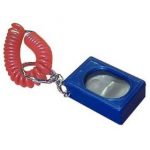 Clicker training is the most positive form of training used with dogs and other animals. It is actually the same method of training used with marine animals, like Dolphins and Killer Whales; however marine animal trainers use a whistle instead of a clicker because that sound travels best under water. Believe it or not, you can clicker train cats and parrots and other birds, you can clicker train chickens and horses. You can even clicker train a gold fish!
Clicker training is the most positive form of training used with dogs and other animals. It is actually the same method of training used with marine animals, like Dolphins and Killer Whales; however marine animal trainers use a whistle instead of a clicker because that sound travels best under water. Believe it or not, you can clicker train cats and parrots and other birds, you can clicker train chickens and horses. You can even clicker train a gold fish!
When we use the clicker, we are instantly marking a behavior (putting our stamp of approval on it), and immediately afterward the dog gets rewarded with a food treat or some other valuable reinforcer. The dog quickly learns that when he hears that sound, he’s done something that we like and he’s going to get a cookie!
With some dogs, the sound of the clicker can become more rewarding and motivating than the treat itself. When I trained my Border Collie Jack using this method, he got very excited anytime he saw me bring out the clicker, and sometimes he actually forgot to come and get his treat! Clicker training provides motivation for learning new behaviors!
When using clicker training, we can motivate learning of new behaviors very quickly. When dealing with some serious behavior problems, we’re able to get much quicker results when (1) changing a dog’s negative emotions about something he is fearful of; (2) preventing inappropriate behaviors by teaching alternative or incompatible behaviors; and (3) shaping behaviors to encourage the dog to problem-solve, in order to choose behaviors we like. I have seen phenomenal results using clicker training with shy, fearful and even aggressive dogs. Finally, we can effectively communicate to the animal about what we want, rather than using harsh, verbal commands and corrections.
At no time are corrections or punishments used when clicker training. This helps our dogs trust us and want to work with us, rather than teaching them to choose avoidance behaviors. Clicker trained dogs learn how to control consequences for their behaviors so that desirable, appropriate behaviors work for them. They *think* they’re training us, when we are actually training them.
Once the dog forms better habits, we then stop using the clicker. We also begin replacing food rewards with other reinforcers, like games of fetch, praise, chase games, tug games, long walks, and other activities the dog loves to do.
Click/Treat: How Do I Get Started
In order to teach your dog what clicker training is all about, you need to classically condition him to the sound, and then produce a treat within 1/2 second afterward. This is called “charging the clicker.”
Prepare for your first lesson by having your clicker in hand and a pocketfull of soft treats (biscuits aren’t good enough for this). You want to use soft foods so your dog doesn’t choke on them or have to take forever to chew and swallow them. Have your dog sit in front of you. Click the clicker once, and then offer the dog his treat. Click once again, and treat again. You’ll want to repeat this about 15 times. By the time you’re finished with this exercise, your dog will learn that everytime he hears that click sound, he can rest assured that he’s going to get a tasty tid-bit of food.
If your dog already knows how to sit and/or lie down with a verbal cue, go back to having him do these basic behaviors, but use the clicker this time. Tell your dog to sit. As soon as his butt hits the floor, click and treat (c/t). Praise him also. Go all over your house and ask your dog for sits in each room and in several locations in those rooms. When he sits, c/t. Then ask your dog to lie down. The moment his entire body is flat against the floor, click and treat him. Go around the house asking for downs and c/t each one of them. Once you go through these initial exercises, your dog will have already fallen in love with clicker training. The more you use it, the better he’ll love it.
When you’re first getting started, keep your clicker handy and have treats with you as often as possible. The more clicker training you do, the more appropriate behaviors you will be able to mark and reward.
Can I still use clicker training if my dog is afraid of noises?
I have learned to charge the clicker first at a distance from the noise-phobic dog. If at first it’s just a faint sound, most dogs become accustomed to it gradually as the sound gets closer and a bit louder. If your dog is scared of noises, work on this slowly at first, but it really won’t take too long if you start out muffling the sound before clicking it close by. It might be a good idea for someone to help you by sounding the clicker from upstairs in your house behind a door while you give your dog a treat after he hears it. Little by little, your helper should come just a tad closer while clicking.
If you notice that no matter how far away you click, your dog seems very uncomfortable, you can substitute the sound of the clicker with a click of your tongue or by clicking a pen. Or, if you prefer using a verbal reward-marker, use the word “Yes!” and follow it up with a treat. Charge the word, “YES” the same way you would charge the clicker.
What does “shaping behaviors” mean?
Shaping behaviors means that we reward small increments of behaviors that leads to a final goal behavior. For example, if you want to teach a dog to go into his crate, you would (1) click/treat if he glanced at the crate, (2) click/treat if he took a step toward the crate, (3) click/treat if he put his nose in the crate, (4) click/treat if he put a paw in the crate, (5) click/treat if he walked into the crate (we could “jackpot” that one!). So rewarding little bits of behaviors that lead up to what you’re wanting the dog to do is referred to as “shaping” behaviors.
Have some fun with your dog and just sit quietly and pretend to ignore him. Any behavior he offers that you like, click/treat him for it. You’ll be amazed at how many different behaviors your dog will do in order to hear the clicker and get his cookie.

I’m shaping my behaviors. Click me Mom!
Is the timing of the click important?
Absolutely! When your dog does something correctly, you need to mark it immediately. This is why the clicker is so much better to use. If we use a verbal reward marker, it takes time to take a breath and speak the words necessary to let the dog know he’s done something right. In just that short period of time, the dog could do a different behavior so would not get rewarded for doing what we wanted him to do. He might have blinked his eyes, turned his head to one side, moved a paw, etc. One good way to practice timing is to toss a ball into the air. The moment it hits the ground, click the clicker. Note that it’s not all that easy to do in the beginning. Practice, practice, practice.
Timing is important in order to mark a complete behavior. If you click too soon, you’ll be rewarding a partial behavior. For example, suppose you’re clicking/treating your dog for a sit, but you click too early and she hasn’t yet put her butt on the floor, you’ll wind up teaching her to do a partial sit or a squat.
If you click too late, you could be marking a totally different response. Suppose you want to mark the sit, but you hesitate. Your dog may have sat, but quickly popped back up into a stand. If you clicked at that moment, you told her you liked it that she stood up.
Here’s a common mistake many of us make: suppose you’re training your dog to come when called? You say “Duke, come” and he races over to you. Then, you tell him, “sit!” and you click/treat. You’ve just marked and rewarded the sit, not the “come.”
Do I have to reward with food every time I click?
Food is a primary reinforcer, but if food isn’t what floats your dog’s boat, use a toy or other valuable reinforcer that he finds extremely motivating.
Do I use verbal cues when clicker training?
If you’re clicking and treating a behavior she already knows the verbal cue for, sure go ahead and use that cue (sit!). However, if you’re teaching a new behavior, avoid using any verbal cue until your dog successfully practices that behavior several times and has gotten clicked and treated for it. Once she’s doing the behavior easily, then you want to add the verbal cue right before the dog does the behavior.
Suppose my dog voluntarily offers a new behavior that I didn’t ask for; should I click/treat her for it?
If you like what she just did, click and treat it! If she offers it again, c/t each time she does it. After several successful repetitions, you can now put a verbal cue on it.

Mirror, Mirror on the Wall. I’m the Smartest Poodle of All!
Will the clicker lose its meaning if I don’t always use it?
If the dog does something new that you really like a lot, and you don’t have your clicker or treats with you, you should at least use your verbal reward marker (“YES!”) and reward it with a food treat or the toss of a toy, etc. In other words, have a huge party for her right after she’s done this marvelous performance. But… I would encourage you to keep your clicker and treats handy, especially in the early days and weeks of your training. The more clicking and treating you do, the more behaviors you will be able to mark and reward.
Can I ever wean her off the clicker and treats?
Yes! The clicker is for teaching new behaviors. Once the dog has practiced a new behavior successfully over and over again, you can discontinue the clicker. As far as treats are concerned, you should then randomly reward with a food treat, or toss a ball or frisbee, or play a game of tug, etc. By treating the dog randomly, he will work even harder because he’ll never know when to expect that food treat. This method is referred to as a “slot machine principle.” Sometimes you get that big payoff and sometimes you don’t. If you put money into a slot machine, you know what I’m talking about 😉
Do you have a question about clicker training? Contact me and I’ll answer it for you.
Treat Your Dog Like a Human and He’ll Treat You Like a Dog!
